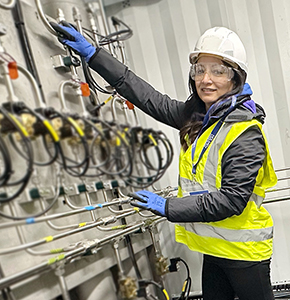Chemical compounds in cranberries are linked to the prevention of urinary tract infections (UTIs) but inconsistencies in methods currently used commercially to measure levels can result in the over- or under-estimation of potency levels, leaving product manufacturers and consumers without good data. A study published today in the Journal of the Science of Food and Agriculture outlines a new, commercially viable method of measuring these compounds.
UTIs are caused by bacterial adhesion (bacteria growth) on cells in the bladder. To maintain urinary tract health, especially for those prone to UTIs, daily consumption of the recommended 36mg of cranberry proanthocyanidins (PACs) has shown effectiveness in inhibiting bacteria from adhering to bladder cells, multiplying and consequently causing infection. This amount of PACs can be easily consumed in a 9-10 oz serving of 27% cranberry juice cocktail.
PACs are small molecules (catechin or epicatechin) molecules linked together to form larger polymers. The PACs in cranberries contain a high proportion of what are called ‘A-type double linkages’ between the catechin or epicatechin molecules. Other food sources of PACs that do not contain these A-type linkages (chocolate, grapes, apples and green tea) do not elicit the bacterial anti-adhesion activity.
With some cranberry product testing methods, overestimation of up to five times the PAC level have been reported. This study uses the new BL-DMAC method of quantifying PAC levels in cranberry products which the authors claim can now serve as the standard industry method, allowing product manufacturers to provide accurate PAC levels.
To evaluate this method, 11 samples of cranberry products were obtained (five from US sources and six from European sources) for PAC quantitation analysis. Powdered samples were coded and sent blinded to five different analytical laboratories (three in the US, one in China and one in Europe) for analysis by the BL-DMAC method. Each laboratory reported statistically consistent results of PAC levels.
'It is important to have an accurate, standard method for cranberry PAC quantitation that can be performed quickly and inexpensively in any commercial lab' said Ronald L Prior, Ph.D, lead author of the study. 'In our study, we have shown that the BL-DMAC method is validated for this use. It utilises a commercially available standard, which is vital to obtaining accurate results among different laboratories.'
'Universal adoption of this standard worldwide by the cranberry industry will allow producers to use one standard method to insure accurate labelling of PAC levels in products, and aid consumers in selecting products with sufficient PAC levels to obtain bacterial anti-adhesion activity,' added Prior.
This study is published in the Journal of the Science of Food and Agriculture. Media wishing to receive a PDF of this article may contact physicalsciencenews@wiley.com.
Full Citation: 'Multi-Laboratory Validation of a Standard Method Quantitating Proanthocyanidins in Cranberry Powders' Ronald . Prior, Ellen Fan, Hongping Ji, Amy Howell, Christian Nio, Mark J Payne, and Jess Reed. Journal of the Science of Food and Agriculture; 2010 DOI: 10.1002/jsfa.3966
About the Author: Ronald L Prior, Ph D is a Research Chemist for the USDA, Arkansas Children’s Nutrition Center and a professor of Food Science at the University of Arkansas, Fayetteville.
To arrange an interview with Dr Prior, please contact Marcia Wood at +301-504-1662 or Marcia.Wood@ars.usda.gov
Ends
About JSFA
Journal of the Science of Food and Agriculture publishes peer-reviewed original research, reviews, mini-reviews, perspectives and spotlights in these areas, with particular emphasis on interdisciplinary studies at the agriculture/ food interface. This international journal covers fundamental and applied research, including: food, health and nutrition, food science and technology, biotechnology, molecular biology, biochemistry, food safety, materials and processing, agriculture production, utilisation, and environment, as well as sensory and consumer sciences. The Journal of the Science of Food and Agriculture is published by Wiley on behalf of SCI.
About SCI
SCI, the society where science meets business on independent, impartial ground is a unique international forum which anyone can join where they can share and exchange information, ideas, new innovations and research and access SCI’s growing database of member specialists between sectors as diverse as food and agriculture, pharmaceuticals, biotechnology, environmental science and safety. Originally established in 1881, SCI is a registered charity with members in over 90 countries. For more information on SCI activities and publications, click here.








